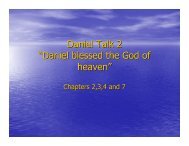Handout - Western Christadelphian Bible School
Handout - Western Christadelphian Bible School
Handout - Western Christadelphian Bible School
You also want an ePaper? Increase the reach of your titles
YUMPU automatically turns print PDFs into web optimized ePapers that Google loves.
2 Inference<br />
Moses did not teach resurrection by direct statement. But his record implies it:<br />
“Now that the dead are raised, even Moses shewed at the bush, when he calleth the<br />
Lord the God of Abraham, and the God of Isaac, and the God of Jacob. For he is not a<br />
God of the dead, but of the living: for all live unto him” (Luke 20:37, 38).<br />
In this wonderful deduction, based on Sadducee premises, Jesus confuted their stilted views<br />
about the power of God.<br />
There are many inferences within the scripture record. The writer to the Hebrews inferred<br />
Abraham’s belief in Isaac’s resurrection (Heb. 11:19 - probably from Gen. 22:5). Eli never<br />
literally kicked at God’s sacrifices, although his actions implied as much (1 Sam. 2:29).<br />
Aaron’s subservience to Melchisedec is inferred from Abraham’s paying tithes to<br />
Melchisedec (Heb. 7:1-10). Most of the spiritual teaching behind the Law of Moses is<br />
implied; as, for example, Paul’s inference that God will reward our efforts and sacrifices -<br />
from the law about muzzling oxen (1 Cor. 9:9). The list is very long. Inspiration has<br />
elevated such inferences to the level of reliability of direct statements.<br />
We may use the same process, but our conclusions will be more cautious. A deduction may<br />
never be more reliable than its premises, nor more sound than the logic by which it is formed.<br />
We are at risk, sometimes, of overlooking shaky premises because of the elegance of the<br />
logic. Although correct logic is true whether or not it is perceived in the human mind, the<br />
mind must enter the process whenever logic is used. To that extent, then, the logic is<br />
questionable - inconsistencies may go undetected.<br />
So, although we may infer what scripture implies, we must look behind the deduction -<br />
testing the soundness of the premises and of the logic that links them to the conclusion.<br />
3 Parallel Passages<br />
This is a peculiarly scriptural method, and we use it automatically. When faced with a<br />
passage the meaning of which is unclear, we identify some characteristic subject matter,<br />
language or figure, and use it to align the passage with another showing the same peculiarity,<br />
but whose meaning is less obscure. The second passage is then used to explain the first on<br />
the assumption that both are saying the same thing.<br />
Evidently we are intended to do this. None would attempt a study of the life of the Lord<br />
from, say, Matthew, without also referring to Mark, Luke, John and comments elsewhere.<br />
And who would study the kings of Judah without reference to Samuel, Kings, Chronicles,<br />
Isaiah, Jeremiah and many others of the prophets?<br />
Even when confronted with a direct statement, we “instinctively” (actually, we’ve learned to<br />
do this) turn to parallel passages to throw more light on the subject, if possible. And - with<br />
good reason - few of us are truly comfortable with an idea that is supported by only one or<br />
two contexts. Fundamental teachings are frequent themes in scripture - they rarely rely on<br />
isolated texts.<br />
Some <strong>Bible</strong> themes are of enormous breadth and complexity. For example, Latter Day<br />
Prophecy. Yet even here - indeed, especially here - a systematic approach, assessing the<br />
reliability of each step, can pay handsomely. We may decide, say, that Ezekiel 38 is a direct<br />
statement about Russia’s invasion of the land, and use that as a reference against which to<br />
explore other similar passages such as Joel’s prophecy, Zechariah 14, Daniel 11 and 12, 2<br />
Thessalonians 2, the Olivet prophecy and so forth - by identifying parallel events and figures<br />
of speech. Arranging parallel passages “alongside” each other, “vertically”, so to speak, and<br />
then drawing “horizontal” links through their similarities or identities enables a more<br />
complete view to be gained without recourse to guesswork.<br />
Page 9







